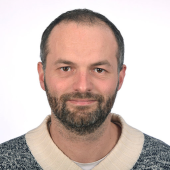
|
Summer school on the topic of deformation in robotics
4-8 Jul 2022 Villeneuve d'Ascq (Lille) (France)
|
|
|
|
Lectures and Keynotes > Day 2 - ModelingDay 2 - Modeling9:00-10:00: Lecture "Continuum Mechanics for the Modeling of Elastic Bodies and Numerical Resolution" - Christian DuriezAbstract: This class will aim at giving the basics of the mechanics of deformable solids (continuum mechanics). I will then explain how numerical models can be used to solve these equations, in particular finite element models. Finally, we will see how we can apply these models in a deformable robotics context, in particular for real-time execution.  Bio: I received an engineering degree from the Institut Catholique d’Arts et Métiers of Lille, France and a PhD degree in robotics from University of Evry, France. My thesis work was realized at CEA/Robotics and Interactive Systems Technologies followed by a postdoctoral position at the CIMIT SimGroup in Boston. I arrived at INRIA in 2006 in the ALCOVE team to work on interactive simulations of deformable objects and haptic rendering. In 2009, I was the vice-head of SHACRA team and focus on medical simulation. I am now the head of DEFROST team, created in January 2015 . My research topics are Soft Robot models and control, Fast Finite Element Methods, simulation of contact response and other complex mechanical interactions, new algorithms for haptics… All my research results are developed in SOFA, which is a framework that we co-develop with other INRIA teams. I was also one of the founders of the start-up company InSimo which use our research results for a fantastic humanitarian project 10:00-11:00: Lecture "The Model of Cosserat Rods: A Standard for Modeling Soft and Continuum Robots" - Frédéric BoyerAbstract: At the crossroads of rigid body mechanics and continuum mechanics, the Cosserat rod model is an ideal tool for the study of slender bodies undergoing large deformations. Initially presented as an abstract object by the Cosserat brothers, it has been applied over time to many problems in engineering sciences such as structural mechanics, where it gave birth to the geometrically exact finite element method (GE-FEM), in ocean engineering for the simulation of submarine cables, or in computer graphics, for the needs of interactive simulation. In robotics, whether for the study of hyper-redundant bioinspired locomotion, the simulation, and control of non-invasive continuous medical robots or for the design of new concepts of soft arms, it is gradually becoming a standard, comparable to the multi-body models of rigid robotics. In this course, we will present this model and some of its uses for robotics. We will start by defining a Cosserat media and the resulting beam kinematics. On this basis, we will establish the equations of the dynamics and the constitutive law of Cosserat rods. This model will then be exploited for the modeling of soft and continuous robots. The connection of Cosserat beams in a robotic architecture as well as the modeling of distributed actuation will be given special attention. On the basis of these results in modeling, we will address the problems of simulation (shooting method, Lagrangian), and control of continuous and soft robots.
11:30-12:30: Lecture "Introduction to Constraints: Contact/Friction/Actuator. Static and Dynamic Model and Modeling of Hybrid Rigid/Soft Structures" - Christian Duriez & Eulalie CoevoetAbstract: This class will introduce a Lagrangian formulation of mechanics, allowing to pass easily from a state space to another, facilitating a reduced parameterization of the deformation models and allowing to get hybrid rigid/deformable dynamic models. We will see two types of projections: the first to reduce the number of Degrees Of Freedom (DOF) and the second for the selection of DOF. Then, we will introduce the constraints for modeling the actuators, the sensors, the contacts with environment and the friction. Direct and inverse modeling and the associated solvers will be explained.  Bio: Eulalie Coevoet received a Bachelor’s degree in Mathematics from the University Claude Bernard in Lyon, France in 2011, and a Master’s degree in Advanced Scientific Computing from the University of Lille, France in 2013. She did a Ph.D in Computer Science at the University of Lille and INRIA Lille in the DEFROST team from 2017 to 2019. Her research results have been developed in the SoftRobots and SoftRobots.Inverse plugins for the simulation framework SOFA. After her Ph.D she went to the University of McGill in Montreal, Canada, in the Computer Animation and Interaction Capture Lab as a postdoctoral fellow. Eulalie is now back in the DEFROST team at INRIA Lille as a Research Engineer. She mainly works on physically-based simulation for the modelling and control of soft robots.
13:30-14:30: Keynote "Deformable Worlds and Deformable Robots: Historical Evolution of Some Robotic Applications" - Maud MarchalAbstract: This course will retrace an historical evolution of the influence of deformations on the design of robots and their environments.  Bio: Maud Marchal is a Full Professor in Computer Science at INSA Rennes and IRISA research unit. She is also a Junior Member of Institut Universitaire de France since 2018. She works on physically-based simulation since her PhD in 2006 at University Joseph Fourier, Grenoble. Since 2008 and her position at INSA, she has explored and contributed to novel Virtual Reality applications, gathering her expertise on haptic feedback, 3D interaction techniques and interactive physically-based simulations. She is involved in program committees of major conferences of computer graphics, virtual reality and haptics and Associate Editor of IEEE Transactions on Visualization and Computer Graphics, IEEE Computer Graphics and Applications, IEEE Transactions on Haptics, ACM Transactions on Applied Perception and Computers & Graphics. She has notably been Program Chair of IEEE Virtual Reality Conference in 2018, 2020 and 2021, Program Chair of IEEE Symposium on Mixed and Augmented Reality in 2021 and General Chair of ACM SIGGRAPH/Eurographics Symposium on Computer Animation in 2018. |

